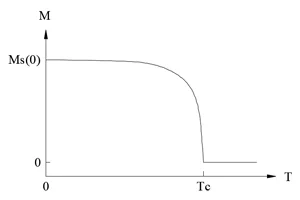Curie temperature (Tc), or Curie point, is a transition point where a magnet loses its spontaneous magnetization when it is heated to the Tc point. Below the Tc point, a ferromagnet or ferrimagnet has its spontaneous magnetization due to alignment of atomic magnetic moments. Above the Tc point, as energy is absorbed to disorder the magnetic moments, it turns to be paramagnetic.

Table 1. Some magnetic materials’ Curie temperature, maximum operating temperature [1]–[6]
| Material | Tc | Max. Operating Temperature | ||||
| K | °C | °F | K | °C | °F | |
| Iron | 1043 | 770 | 1418 | |||
| Cobalt | 1388 | 1115 | 2039 | |||
| Nickel | 628 | 355 | 671 | |||
| Samarium Cobalt | 973-1123 | 700-850 | 1292-1562 | 623 | 350 | 660 |
| Neodymium Magnet | 583-673 | 310-400 | 590-752 | 503 | 230 | 446 |
| Sm2Fe17N3 | 749 | 476 | 889 | 473 | 200 | 392 |
| Ceramic Magnet | 723 | 450 | 842 | 523 | 250 | 482 |
| Fe3O4 | 860 | 587 | 1089 | |||
| Alnico | 1023-1163 | 750-890 | 1382-1634 | 823 | 550 | 1020 |
| Fe-Cr-Co | 913 | 640 | 1184 | 773 | 500 | 932 |
| CoPt | 840 | 567 | 1053 | |||
| Permalloy | 843 | 570 | 1058 | |||
| MnBi | 633 | 360 | 680 | |||
References
[1] J.M.D. Coey, Magnetism and Magnetic Materials, Cambridge University Press & Peking University Press, 2014.
[2] PRC National Standard GB/T 4180-2012, Permanent Magnetic Material of Rare Earth Cobalt.
[3] PRC National Standard GB/T 13560-2009, Materials for Sintered Neodymium Iron Boron Permanent Magnets.
[4] MMPA Standard 0100-00, Standard Specifications for Permanent Magnet Materials.
[5] Shouzeng Zhou, Qingfei Dong, Super Strong Permanent Magnets, Metallurgical Industry Press, 2004.